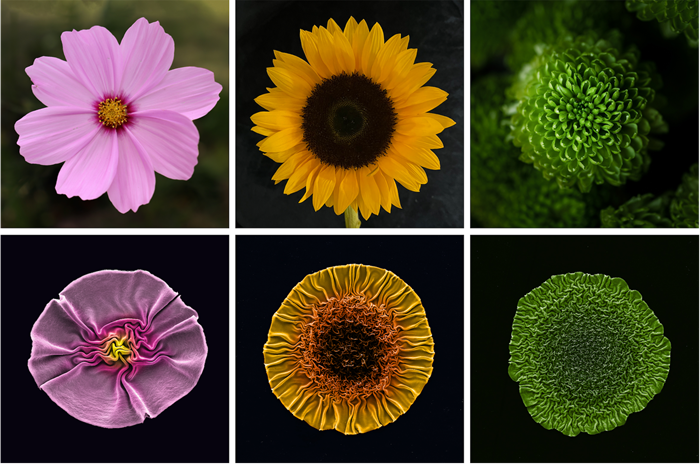While preparing slides to be examined under a powerful microscope, a team of McMaster researchers who frequently work with bacteriophage viruses that consume bacteria had a pleasant and potentially very significant surprise.
 A colorization comparing some phage structures with the flowers they closely resemble. Phages in such structures are 100 times more efficient at targeting bacteria. Image Credit: McMaster University
A colorization comparing some phage structures with the flowers they closely resemble. Phages in such structures are 100 times more efficient at targeting bacteria. Image Credit: McMaster University
The researchers were shocked to see that samples of what is colloquially referred to as phages had united into three-dimensional structures that resembled sunflowers but were barely two-tenths of a millimeter wide after being treated so they could be seen alive under an electron microscope.
Nature had provided the exact structure that specialists in their field have been attempting to create artificially for decades with a little prodding; it turns out that this structure is 100 times more effective than unlinked phages at locating elusive bacterial targets.
According to the researchers, the ability to build such structures opens up possibilities for the use of natural materials and procedures in the diagnosis and treatment of a wide range of diseases.
The study was published in the journal Advanced Functional Materials.
A Happy Accident
The first discovery was a happy accident while doing routine laboratory work.
Lead Author Lei Tian and his colleagues chose to treat the sample phages with high-pressure carbon dioxide rather than subject them to standard preparation procedures, which include temperatures or solvents that kill viruses.
Tian led the study as a PhD student and then as a Postdoctoral Research Fellow at McMaster. He is currently a Primary Investigator at Southeast University in China.
Researchers were shocked to discover that the phages had gathered together in intricate, organic, and very beneficial shapes following the treatment, even though they are accustomed to witnessing the remarkable feats of minuscule viruses.
We were trying to protect the structure of this beneficial virus. That was the technical challenge we were trying to overcome. What we got was this amazing structure, which was made by nature itself.”
Lei Tian, Study Lead Author and Primary Investigator, Southeast University
Using the resources of the Canadian Centre for Electron Microscopy, which is situated at McMaster, the researchers took pictures of the formations. Over the past two years, they have been able to unravel the process and demonstrate how the new structures can be extremely helpful in both science and medicine.
It was an accidental discovery. When we took them out of the high-pressure chamber and saw these beautiful flowers, it completely blew our minds. It took us two years to discover how and why this happened and opened the door to being able to create similar structures with other protein-based materials.”
Tohid Didar, Mechanical Engineer and Study Corresponding Author, McMaster University
Tohid Didar holds the Canada Research Chair in Nano-Biomaterials.
Building with Nature
By enabling the beneficial viruses to bind together like a living, microscopic fabric and even to form a gel that is visible to the naked eye, researchers in the lab of Senior Author Zeinab Hosseinidoust, a Chemical and Biomedical Engineer who holds the Canada Research Chair in Bacteriophage Bioengineering, have made significant strides in phage research in recent years.
This has opened up new possibilities for their application, especially in detecting and combating infection.
However, before the more recent finding, the substance lacked the depth and shape that the flower-like structures' peaks, wrinkles, and crevices provide.
This is really about building with nature. This kind of beautiful, wrinkled structure is ubiquitous in nature. The mechanical, optical, and biological properties of this kind of structure have inspired engineers over decades to build these kinds of structures artificially, in the hope of getting the same kind of properties out of them.”
Zeinab Hosseinidoust, Study Senior Author and Chemical and Biomedical Engineer, McMaster University
The researchers are amazed at the collective efficiency the phages gain by combining and taking such forms, and they are looking at ways to use the same properties now that they have successfully replicated the process and sparked such a change.
By combining the porous, flower-like phage structures with DNAzymes made by their colleagues in the field of infectious disease research, the authors were able to demonstrate that the structures are 100 times more effective than their unlinked counterparts at locating scattered, diffuse targets even in complex environments. They also used the formations to identify low concentrations of Legionella bacteria in water from commercial cooling towers.
A New Age of Phages
Bacteriophages are gaining renewed attention as treatments for various infections due to their ability to be programmed to specifically target harmful bacteria while sparing others.
Following the discovery of penicillin in the middle of the 20th century, research in the field had declined, but as the efficacy of current antibiotics is being diminished by antimicrobial resistance, scientists and engineers including the McMaster researchers are turning their focus back to phages.
Their already remarkable abilities to locate and eliminate certain bacteria as well as act as scaffolding for other advantageous microbes and materials can be enhanced by the identification of the mechanism that leads them to join into flower forms.
Hosseinidoust said, “Nature is so powerful and so intelligent. As engineers, it is our job to learn how it works, so we can harness processes like this and put them to use. The possibilities are endless because now we can make structures using biological building blocks.”
Source:
Journal reference:
Tian, L., et al. (2024) Virus‐Assembled Biofunctional Microarrays with Hierarchical 3D Nano‐Reticular Network. Advanced Functional Materials. doi.org/10.1002/adfm.202414375.